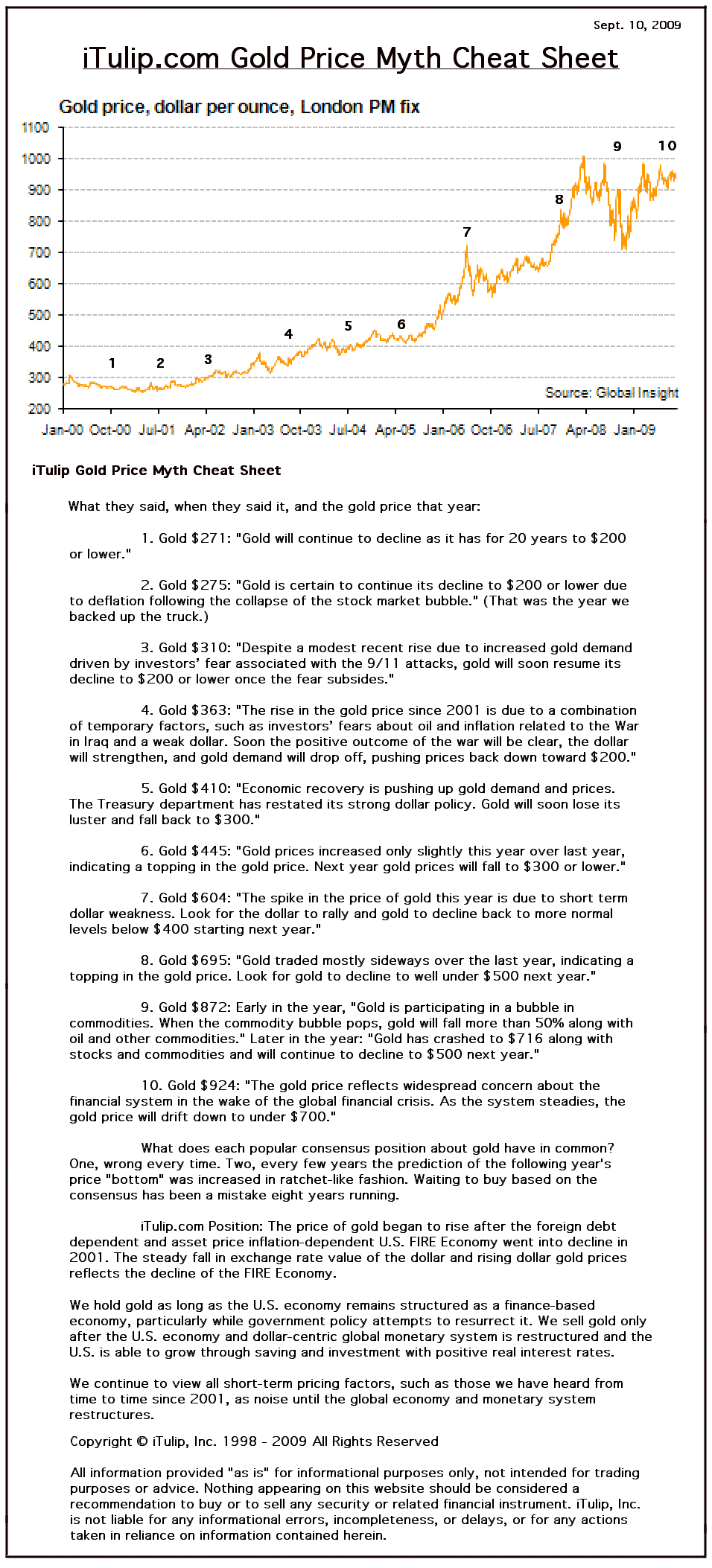
http://docs.google.com/fileview?id=0B3gFAVhH-wC6ZjA2YzQyZTYtZTY4Zi00MGJmLTk1ZDMtZjIwODI0YWE0MjYz&hl=en
iTulip.com Gold Myths Cheat Sheet
An eight-year-old bull market in gold has spawned more erroneous theories and timing calls along the way than you can count. We break it down to the Top Eight Myths and recount the consensus opinion on gold since the bull began in 2001.
Here are eight popular myths about gold that we have collected since 2001 when we put 15% of our portfolio into the yellow metal (with the iTulip counter-argument in parentheses):
A. Earns no interest. (Gold has out-performed stocks and bonds every year since 2001 in real terms.)
B. Performs poorly on the long term. (True, unless the currency is in long term decline due to structural economic imbalances and negative interest rates are maintained for extended periods to stimulate economic growth of the imbalanced economy.)
C. Better inflation hedges exist, such as TIPS. (Inflation is a secondary effect of a weak currency. Gold hedges dollar currency risk directly, inflation risk indirectly; dollar denominated bonds cannot.)
D. Is money (In order to qualify as money gold must act as both a store of value and means of exchange. We use cigarettes in a prison as an example. You must convert gold to dollars before you can make purchases in the U.S. so gold only meets the first criteria. Gold is a currency. We call it the Fourth Currency because it competes with the dollar, euro, and yen in international currency markets.)
E. Price is primarily determined by physical demand for gold. (That's backwards. The gold price is primarily determined by global demand for the currency that is used as the unit to measure the gold price.)
F. The dollar will strengthen relative to other currencies and push down the dollar price of gold. (The dollar's long-term value is determined by international political relationships. Its short-term price is influenced by economic events. The long-term trend is negative because the dollar is a reserve currency nearing the end of its life span. Short-term value fluctuations are irrelevant to non-traders.)
G. Asset price deflation will result from a collapsing credit bubble. Central banks cannot contain the asset price deflation. It will spill over into wage and commodity prices and crash the price of gold. (Central banks can create infinite money through the process of double entry bookkeeping. Consider, for example, TARP.)
H. The smart moneys wait for F. and G. to happen before taking a position in gold.
Below we list the popular consensus about gold that we heard over the years since 2000, prefaced by the cumulative average gold price that year.
What they said, when they said it, and the gold price that year:
1. Gold $271: "Gold will continue to decline as it has for 20 years to $200 or lower."
2. Gold $275: "Gold is certain to continue its decline to $200 or lower due to deflation following the collapse of the stock market bubble." (That was the year we backed up the truck.)
3. Gold $310: "Despite a modest recent rise due to increased gold demand driven by investors’ fear associated with the 9/11 attacks, gold will soon resume its decline to $200 or lower once the fear subsides."
4. Gold $363: "The rise in the gold price since 2001 is due to a combination of temporary factors, such as investors’ fears about oil and inflation related to the War in Iraq and a weak dollar. Soon the positive outcome of the war will be clear, the dollar will strengthen, and gold demand will drop off, pushing prices back down toward $200."
5. Gold $410: "Economic recovery is pushing up gold demand and prices. The Treasury department has restated its strong dollar policy. Gold will soon lose its luster and fall back to $300."
6. Gold $445: "Gold prices increased only slightly this year over last year, indicating a topping in the gold price. Next year gold prices will fall to $300 or lower."
7. Gold $604: "The spike in the price of gold this year is due to short term dollar weakness. Look for the dollar to rally and gold to decline back to more normal levels below $400 starting next year."
8. Gold $695: "Gold traded mostly sideways over the last year, indicating a topping in the gold price. Look for gold to decline to well under $500 next year."
9. Gold $872: Early in the year, "Gold is participating in a bubble in commodities. When the commodity bubble pops, gold will fall more than 50% along with oil and other commodities." Later in the year: "Gold has crashed to $716 along with stocks and commodities and will continue to decline to $500 next year."
10. Gold $924: "The gold price reflects widespread concern about the financial system in the wake of the global financial crisis. As the system steadies, the gold price will drift down to under $700."
What does each popular consensus position about gold have in common? One, wrong every time. Two, every few years the prediction of the following year's price "bottom" was increased in ratchet-like fashion. Waiting to buy based on the consensus has been a mistake eight years running.
iTulip.com Position: The price of gold began to rise after the foreign debt dependent and asset price inflation-dependent U.S. FIRE Economy went into decline in 2001. The steady fall in exchange rate value of the dollar and rising dollar gold prices reflects the decline of the FIRE Economy.
We hold gold as long as the U.S. economy remains structured as a finance-based economy, particularly while government policy attempts to resurrect it. We sell gold only after the U.S. economy and dollar-centric global monetary system is restructured and the U.S. is able to grow through saving and investment with positive real interest rates.
We continue to view all short-term pricing factors, such as those we have heard from time to time since 2001, as noise until the global economy and monetary system restructures.
No comments:
Post a Comment